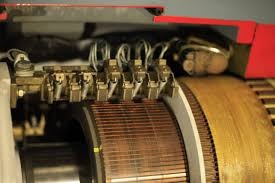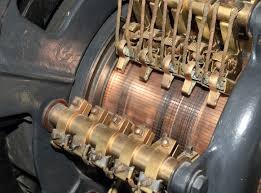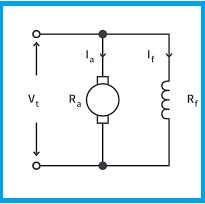DC Motor Diagram | DC Motor Working Principle DC Motor | Brushless DC Motor | Types of DC Motor | Speed Control of DC Motor | DC Motor Speed Control | Working Principle of DC Motor
A DC motor is a device that converts electrical energy into mechanical energy. It operates on the principle of electromagnetic induction, where the interaction between a magnetic field and an electric current generates a rotational motion. This article will provide a detailed insight into the working principle of DC motors, the significance of back EMF, and the types of DC motor.
What is a DC Motor?
A DC (Direct Current) motor is an electrical device that converts electrical energy into mechanical energy. It is a type of electric motor that operates on the principle of electromagnetic induction. DC motors have various applications, including electric vehicles, robotics, industrial machinery, and many others. The basic components of a DC motor include a stator (stationary part), a rotor (rotating part), a commutator, and brushes.
How A DC Motor Works?
A DC motor works on the principle of electromagnetic induction. When a current-carrying conductor is placed in a magnetic field, it experiences a force that generates rotational motion. The basic operation of a DC motor involves the interaction between the magnetic field of the stator and the electric current flowing through the rotor. The stator produces a magnetic field, and the rotor carries the current that interacts with the magnetic field, producing a torque that rotates the motor shaft.
The commutator and brushes play a vital role in the operation of a DC motor. The commutator is a rotary electrical switch that reverses the direction of the current flowing through the rotor as it rotates, ensuring that the rotor's magnetic field is always in the right direction. The brushes are carbon blocks that make contact with the commutator, transferring the electrical current from the power source to the rotor.
DC Motor Working Principle
DC Motor Working Principle is based on the interaction between the magnetic field and the electric current flowing through the rotor. When a current-carrying conductor is placed in a magnetic field, it experiences a force that generates rotational motion. In a DC motor, the stator produces a magnetic field, and the rotor carries the current that interacts with the magnetic field, generating a torque that rotates the motor shaft.
The basic principle of electromagnetic induction is utilized in a DC motor, where a current-carrying conductor in a magnetic field experiences a force, known as the Lorentz force, that causes it to move. This principle is also used in other types of motors, such as AC (Alternating Current) motors.
Back EMF
Back EMF (Electromotive Force) is an opposing voltage that is generated in a motor due to the rotation of the rotor. When the rotor rotates, it generates an electric current that opposes the applied voltage, producing a back EMF. The magnitude of back EMF increases with the speed of the motor.
The back EMF plays a significant role in the operation of a DC motor. As the motor gains speed, the back EMF increases, limiting the current flow through the motor, preventing it from overheating. The back EMF is also utilized in motor control, where it is measured to determine the motor speed and control its operation.
Significance of Back EMF
The back EMF is significant in DC motors as it limits the current flow and prevents the motor from overheating. When the motor is started, the current flow is maximum, and the back EMF is minimum. As the motor gains speed, the back EMF increases, reducing the current flow through the motor. This prevents the motor from overheating, increasing its efficiency and lifespan.
The back EMF is also used in motor control, where it is measured to determine the motor speed and control its operation. Motor controllers use the back EMF to adjust the applied voltage to the motor, maintaining a constant speed under varying loads.
Types Of DC Motors
DC motors can be broadly classified into two types: brushed DC motors and brushless DC motors. Brushed DC motors use carbon brushes to transfer electrical energy to the rotor, whereas brushless DC motors use electronic commutation to transfer energy to the rotor.
Brushed DC motors are relatively simple and less expensive compared to brushless DC motors. However, they require regular maintenance as the brushes wear out over time, reducing the motor's efficiency and lifespan.
Brushless DC motors are more efficient and reliable than brushed DC motors as they do not use brushes that wear out. Instead, they use electronic commutation, which involves the use of electronic switches to control the current flow to the motor. Brushless DC motors are more complex and expensive than brushed DC motors, but they offer better performance and durability.
In addition to these types, DC motors can also be further classified based on their construction, such as permanent magnet DC motors, shunt DC motors, series DC motors, and compound DC motors. Each type of DC motor has its unique characteristics and applications, making them suitable for various industries and fields.
Permanent Magnet DC Motors: These motors use a permanent magnet as the rotor and have a simple construction. They are compact, efficient, and have a high starting torque, which makes them suitable for a variety of applications, including robotics, automation, and small appliances.
Shunt DC Motors: Shunt DC motors have a parallel (shunt) connection between the armature and field windings. These motors have a constant speed characteristic, as the field current remains constant, and the armature current varies with the load. They are commonly used in applications where speed control is important, such as conveyor systems and machine tools.
Series DC Motors: In series DC motors, the armature and field windings are connected in series. These motors have a high starting torque and can produce very high speeds, but their speed varies greatly with the load. Series DC motors are commonly used in applications where high torque is required, such as in locomotives, cranes, and elevators.
Compound DC Motors: Compound DC motors have both series and shunt field windings. This results in a motor that has a combination of the characteristics of both series and shunt motors. There are two types of compound DC motors: cumulative compound and differential compound. Cumulative compound motors have a stronger field as the load increases, while differential compound motors have a weaker field as the load increases. Compound DC motors are used in applications where both high starting torque and speed control are required, such as in printing presses and textile machinery.
DC Vs AC Motor
DC motors and AC motors are two different types of electric motors that have different characteristics and applications. Here are some of the key differences between the two:Power source: DC motors run on DC (direct current) power, while AC motors run on AC (alternating current) power.
Commutation: DC motors have a commutator that helps to switch the direction of the current flowing through the rotor. AC motors do not have a commutator, as the direction of the current alternates automatically with the AC power source.
Speed control: DC motors are generally easier to control for speed, as the voltage to the motor can be varied to change the speed of the motor. AC motors are typically more difficult to control for speed, as the frequency of the AC power source affects the speed of the motor.
Efficiency: DC motors are generally more efficient at producing high torque at low speeds, while AC motors are generally more efficient at producing high speeds.
Applications: DC motors are often used in applications that require precise speed control, such as robotics, conveyor systems, and machine tools. AC motors are used in a wide range of applications, including HVAC systems, industrial machinery, and electric vehicles.
DC Motor EMF and related Equations
When a DC motor is in operation, a back EMF (electromotive force) is generated due to the rotation of the motor's armature within a magnetic field. The back EMF is proportional to the speed of the motor and opposes the applied voltage, which limits the current flowing through the motor.
The equation for back EMF (Eb) can be written as:
Eb = K * ω
where K is the motor's back EMF constant (measured in volts per radian per second) and ω is the angular velocity of the motor's armature (measured in radians per second).
The back EMF equation can be rearranged to solve for the motor's speed:
ω = (V - Ia * Ra) / K
where V is the applied voltage, Ia is the motor's armature current, and Ra is the armature resistance.
The above equation shows that the motor's speed is inversely proportional to the armature current and directly proportional to the applied voltage.
Another important equation related to DC motors is the torque equation, which relates the motor's torque to its armature current:
T = Kt * Ia
where Kt is the motor's torque constant (measured in newton-meters per ampere), and Ia is the armature current.
Speed Control of DC Motor
DC motors are widely used in various applications because of their speed control capabilities. There are several methods for controlling the speed of a DC motor, including:
Armature Voltage Control: This method involves varying the voltage applied to the motor's armature to control its speed. By reducing the armature voltage, the motor's speed can be reduced, while increasing the armature voltage will increase the speed.
Field Flux Control: In this method, the field current is varied to change the motor's magnetic field strength, which affects its speed. By reducing the field current, the magnetic field strength decreases, resulting in a decrease in motor speed.
Armature Resistance Control: This method involves changing the resistance of the motor's armature to control its speed. By increasing the armature resistance, the current flowing through the armature is reduced, which results in a decrease in motor speed.
The method used for speed control depends on the specific application and the requirements of the motor. Each method has its own advantages and disadvantages, and the choice of method depends on factors such as cost, complexity, and precision of control required.
Conclusion
In conclusion, understanding the principles and operation of a DC motor is crucial in designing and utilizing these devices in various applications. Back EMF plays a significant role in the efficient operation and control of DC motors, and various types of DC motors offer different advantages and disadvantages depending on their construction and application.
FAQ
What is a DC motor and how it works?
A DC motor is an electrical device that converts electrical energy into mechanical energy. It operates on the principle of electromagnetic induction, where the interaction between the magnetic field and electric current flowing through the rotor produces a torque that rotates the motor shaft. DC motors have a stator, rotor, commutator, and brushes that play a vital role in the motor's operation.
What are the 3 types of DC motors?
The three types of DC motors are brushed DC motors, brushless DC motors, and stepper motors. Brushed DC motors use carbon brushes to transfer electrical energy to the rotor, while brushless DC motors use electronic commutation to transfer energy to the rotor. Stepper motors operate on a digital pulse sequence and rotate in small, precise steps.
What is a DC motor used for?
What is the meaning of DC motor?
What are the 4 types of DC motors?
The four types of DC motors are brushed DC motors, brushless DC motors, stepper motors, and servo motors. Servo motors are a type of DC motor that is used for precise control in applications such as robotics and automation.
What is the difference between AC and DC motor?
The primary difference between AC and DC motors is the source of power they use. AC motors use alternating current, while DC motors use direct current. AC motors do not require brushes and commutators, making them simpler and less expensive than DC motors. However, DC motors offer better control, speed, and torque characteristics, making them suitable for various applications.
Which motor is stronger, AC or DC?
The strength of a motor depends on various factors, such as its size, design, and application. In general, DC motors are considered to be stronger than AC motors as they offer better control, speed, and torque characteristics. However, AC motors are more efficient and less expensive than DC motors.
Which is better, AC or DC?
The choice between AC and DC motor depends on the specific application and requirements. AC motors are simpler, less expensive, and more efficient than DC motors, making them suitable for applications that require high power output and low maintenance. DC motors offer better control, speed, and torque characteristics, making them suitable for applications that require precise control and high torque.
Why use a DC motor instead of AC?
DC motors are used instead of AC motors when precise control, high torque, and efficient operation are required. DC motors offer better control and speed characteristics, making them suitable for applications that require precise control, such as robotics, automation, and electric vehicles. Additionally, DC motors are more suitable for battery-powered applications as they can operate on direct current.








Post a Comment